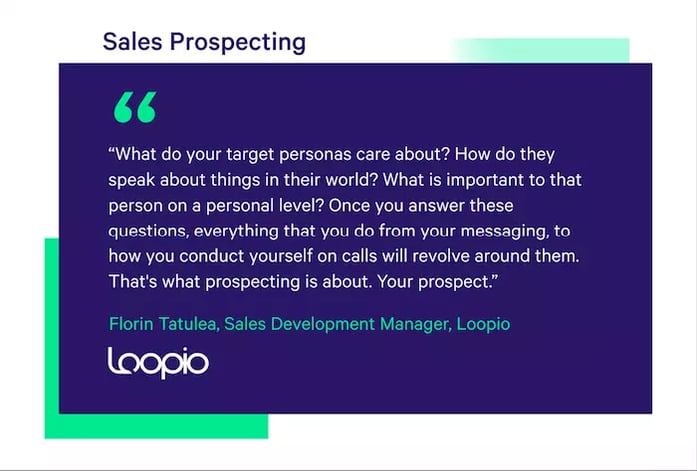Today IBM employs over 370,000 people in more than 170 countries but did you know it was all started by a cold-caller?
Thomas Watson believed in rigorous outbound sales. What worked for him can work for you—you can be that salesperson worth ten others who puts your business on the map. But only if you’re thoughtful in your approach.
You see, sales prospecting is one of the most misrepresented and misunderstood aspects of the sales profession. Prospectors are portrayed in the media as swindlers and scammers. That’s how prospects often see you. It's why many hang up instantly, and why sales prospecting has grown more difficult. It’s also why it's so important to unlearn those stereotypes and forget all the sales prospecting techniques you see in movies like The Wolf of Wall Street. Instead, embrace the timeless fundamentals that can help you conquer any territory and build the basis of a business like IBM.
In this guide, I explain what sales prospecting is, why it’s important, who should do it, and a sales prospecting method to quickly book new meetings.
Prospecting definition: What is sales prospecting?
Sales prospecting is the process of finding and reaching out to prospective buyers to schedule a meeting. It’s the first step in the sales cycle and the most critical. Prospecting is the one skill that sets exceptional salespeople apart—when you know how to generate your own meetings, you’re the captain of your own ship.
The importance of prospecting
The importance of prospecting cannot be overstated. Without salespeople reaching out, building relationships, and coaxing prospects along their buying journey, most deals wouldn’t get done. Eighty percent of people who fill out a form don’t end up booking a call—often, simply because they got busy and forgot. And most potential customers don’t even know to be looking for a solution, wouldn’t recognize it if they saw it, and can’t see upon first glance how it’d work for them.
Before the modern era, sales prospecting is how everything was sold, including household appliances. Thomas Watson, who would go on to found IBM, got his start selling pianos out of the back of a horse-drawn wagon—bringing them to people who’d never otherwise have access. In some ways, sales hasn’t changed. Salespeople are guides.
For all these reasons and more, there must be a salesperson to prospect, initiate conversation, and help people evaluate.
Related Post: Your Essential Sales Glossary—The 99 Terms You Need to Know
What types of sales prospecting are there?
There are two kinds of prospecting: inbound and outbound. With inbound prospecting, the salesperson receives a list from marketing—often with the names of people who filled out a form. With outbound, the salesperson generates their own list and picks their targets. Inbound is sometimes likened to farming. Outbound is likened to hunting.
- Inbound prospecting: The salesperson receives leads.
- Outbound prospecting: The salesperson builds a list and reaches out.
All things being equal, most salespeople prefer inbound leads. They reached out to you, so it’s a warm conversation, and they probably intend to buy. The issue is that there are never enough of them and the deals tend to be smaller. Said one sales director I talked to for this article, “We launched an outbound program because we wanted to reach companies with a higher contract value, and that’s not who was finding us.”
Compared to inbound, outbound prospecting gives you more control. If you’ve heard of account-based marketing, or “ABM,” that’s essentially what this is: You pick companies who you know would be great customers and focus all your energy on just those accounts.
Most sales organizations practice a mix of inbound and outbound—you’ll take what comes inbound and supplement with outbound prospecting.
Who should be doing the sales prospecting?
The most senior person possible. It’s a bit like social media—the best person to run it is the head of marketing. Nobody has a better grasp of the brand message or is better able to distill it into 140 characters. Yet the Twitter account often gets delegated to the intern who says things that aren’t very interesting and sometimes, wrong.
Sales reps get a bad rap in the media partly because sales organizations are forever trying to ‘farm out’ the procedural tasks like dialing and list building to the most junior people on the team. When junior sales reps don’t fully understand the businesses they’re calling, they have low connect rates and aren’t very convincing. It creates a cycle where they’re constantly being hung up on, chewed out, and demotivated—not to mention, they exhaust their list.
A more senior person like a seasoned account executive is much better suited to sales prospecting. First off, they’ll pick better companies because they have skin in the game—they’ll actually have to manage the deal. They also won’t get tongue-tied on the phone. If the prospect asks who their customers are, they’ll have a pocket story ready.
More than anything else, senior salespeople are better at personalization. They know which elements of an email to personalize and which not to. For example, they know, when reaching out to a healthcare provider, not to say, “Your customers.” (They’re patients.)
Related post: 4 Ways To Offer Personalized Sales at Scale
How to send more emails but keep them feeling personal
With a sales engagement platform like Mixmax, you can send sequences. This means the first email is totally custom, but if they don’t respond, it follows up at a set cadence with personal-feeling reminders that insert elements like their name, company, or title. Suddenly, for every one email you send, you’re really sending seven.
Try it out for free with Mixmax
What channels can I use for outreach?
While there are many channels, the majority of your outreach will likely happen via phone and email.
The most common sales prospecting channels today:
- Phone
- Forums (industry Slack groups, Quora, communities)
- In-person (not much of this happening these days)
- Other
Common sales prospecting tools:
- Mixmax (Send smarter email)
- Vidyard (Send personal videos)
- Dialpad (Call faster)
- Giphy
- SMS
Anatomy of a great cold phone call:
A great phone call doesn’t start off with the line, “Hi my name is X and I’m calling from Y.” Say something else. Anything else. Also:
- Give a credible and compelling reason for reaching out
- Build rapport by pointing out something you have in common
- Read the room
- Go off script
- Presume they want to hear from you
- Seek to understand their objections
Anatomy of a great outbound sales email:
Great outbound sales emails use a subject line that’s intriguing but not deceptive. “Help!” will get you lots of open rates and yet few responses. Also:
- Keep the subject line short (six words or fewer)
- Keep the email short (150 words or less)
- Give a reason for reaching out that shows you’ve done your homework
- Front-load the important information (don’t bury the ask)
- Provide an ultra clear call-to-action (like a calendar link with times)
- Don’t let the personalization seem obvious

Guidelines for prospecting on Slack communities, forums, Google Groups, and Twitter
These work best when you have something genuinely useful to say. It helps to study up and become engrossed in your industry. Otherwise, you risk offending strangers who don’t want to be pitched.
Related Post: Sales Engagement vs. Sales Enablement: What's the Difference, and When Do You Need Them?
A simple four-step sales prospecting method you can borrow
So now that you understand the context, let’s get into the actual act of sales prospecting, where having a process to follow is paramount.
This was Thomas Watson of IBM’s claim to fame—at a time when salespeople had a poor reputation because they’d make big claims and skip town after the sale, his salespeople had integrity.
“The Watsons were the ones who first stressed professionalism in sales,” says Robert L. Shook, author of The Greatest Sales Stories Ever Told. Watson taught his salespeople ethics and made them spend time in the service department fixing machines so they knew what could go wrong. Eventually he founded an internal institute for selling.
This bred a generation of salespeople who remade the stereotype of the fast-talking huckster into a trusted advisor who solves problems—just like you can do today.
Related Post: 75 Sales Prospecting Email Subject Lines to Get More Responses
Step 1: Get convinced of your product’s value
The first key to exceptional sales prospecting is not what you think it is. It is not about volume. It is not about personality. And it is not about technology. The key to being incredible at sales prospecting is the unalterable belief that you are saving not selling.
By this I mean, you believe above all else that your solution is fantastic and that people would be foolish not to buy. Not foolish in a condescending way—foolish in an incredulous way. When someone who obviously has the issue that your solution is designed to solve says, “No thanks, I don’t need it,” you’re not mad—you’re confused. How could they not? You press for more information. Something doesn’t add up. Did they mishear you? Perhaps if you said it in a different way.
The conviction that you are going around providing a cure for an intolerable pain—not just peddling snake oil, but truly saving people—is what sells.
What doesn’t sell is uncertainty. If you yourself can’t envision why someone would buy, your uncertainty validates their uncertainty and you get a lot of “maybes.” If you think it’s too expensive, prospects can hear that in your voice and read it in your email opener.
If you do not tackle this initial confidence in your product, why it exists, and the stories of the people it helps, nothing else will work.
Step 2: Build a clean list
Once you are convinced of the value of your product, build a list of companies and contacts who are likely to feel the same way. I cannot overstate the value of this preparation. As Abraham Lincoln said, “If you give me six hours to chop down a tree, I’ll spend the first four sharpening the ax.” Sharpen your list to such a fine point that there’s nobody in there to waste your time. Otherwise, they will, and it’ll cost you dearly in lost sales prospecting productivity.
Begin by building a list of all possible accounts. If you’re practicing inbound sales, and marketing provides the list, your work may be mostly done for you. In outbound, if you’re lucky, you’ll have a CRM of old accounts and contacts to trawl through. If not, you’ll likely be looking online or to data provider services:
- ZoomInfo or DiscoverOrg
- Funding announcements
- Conference sponsorship lists
- Conference attendee lists
- Top 100 “tech companies” or “restaurants in New Jersey” lists
- Job boards
Whether inbound or outbound, it’s a good idea to automate what you can and get alerts for important moments, like an account getting funded. Create a Google News Alert for terms relevant to your territory (it’s free) and alerts in any news alert sales tools like Owler, LinkedIn Sales Navigator, and the like. (See our list of the 13 top sales tools.)
Next, eliminate any accounts on your list that have deal breakers, or reasons they wouldn’t be able to purchase. For example, if you can only sell to companies that have Salesforce CRM, use a tool like Datanyze to check all their websites. This prevents you from wasting time reaching out to accounts that could never actually turn into deals.
From your full list, peel off a shortlist of about 20 accounts for active sales prospecting. Look up the contact and their info from those accounts.
To build your list:
- Create a complete list (~100 accounts)
- Eliminate any accounts that have deal breakers
- Create a shortlist (~20 accounts)
Related Post: 18 Sales Prospecting Email Templates That Get Responses
Step 3: Reach out in a personal way
The key to outreach is personalization. If you can hand the more routine aspects of outreach over to a software in a way that doesn’t degrade the customer experience, you should.
For example, if your first emails are always custom but the follow-ups are always the same, use a sales engagement tool like Mixmax to set sequences. The system will conduct all the follow-ups for you. If someone replies or books a meeting, it takes them off the sequence. This way, you can focus on writing really good first emails.
Good sales personalization means:
- A personal-feeling greeting (use their name, provide a reason for reaching out)
- A message that’s relevant to their role or industry
- A personal call-to-action
To save time with your personalization, it helps to have a sales engagement tool (like Mixmax) that allows you to, with just a few clicks, insert an industry-specific template that also automatically inserts their name and a link to book time on your calendar. This way, you can send one email to many people and, as Jessica Gulish, VP of Sales at the healthcare startup Spruce says, “You’d be shocked how many people respond thinking you wrote it just for them.”
Then, start sending. Keep yourself consistent by setting inviolable blocks of time every day where you do nothing but sales prospecting. Turn off notifications on your phone and stick to it.
After your first email, start sending messages across different channels, but always reference your outreach on the previous channel. This sales prospecting technique is key. When your voicemail references the email you sent and the email you sent references your LinkedIn InMail, prospects make the connection that it’s you, and that you won’t give up.
Principles for an effective sales prospecting process:
- Address your highest value accounts first. The Pareto principle works in sales prospecting—20% of your deals will retire 80% of your quota. Prioritize the ones that are the most likely to close and have the highest potential value. You can even turn this into an equation—create a spreadsheet with all your accounts and assign the odds that they’ll close (20%, 50%, 80%) as well as the potential value ($12k, $24k, $36k, for example). Multiply them. Order the list (the revenue potential of each deal) from highest to lowest, and work top down.
- Always ask for an intro. Warm outreach (someone else introducing you) always beats cold outreach. Look for others who can give you a warm introduction, including your company’s executives.
- Don’t be salesey. Prospects are programmed to hang up on people who start off calls or emails in ways that sound “salesy.” For example, “Hi, I’m from so-and-so firm …” and “Want more revenue?” Craft your outreach so it doesn’t sound hackneyed. Practice until it’s genuine.
- Help, don’t sell. Nobody wants to be pushed into doing something by a stranger. The more you insist, the more they’ll resist. Instead, take the perspective that you’re there to help them—even if that means they don’t buy from you. If you truly believe in your product, and they don’t want to talk to you, you’ll exude confidence: “How could they not want this given what it can do for them?”
- Don’t scale a broken system. If people aren’t responding to your outreach, you cannot fix the problem by sending yet more outreach. Pause and work on your message. Only do more of it and start sending email sequences when you know your outreach is effective. Often, the issue is that the emails aren’t personalized enough.
- Persistence beats resistance. It takes an average of 7.5 hours of cold calling to book one meeting and an average of eight emails for someone to reply. A vast majority of salespeople give up early, and are forever giving up on leads and accounts that are only halfway there. If you are politely persistent, you will prevail.
Related Post: 55 Sales Prospecting Questions to Get Your Prospects Talking
Step 4: Repeat
Never let up your sales prospecting outreach—even when your calendar is overflowing with meetings. New meetings take time to evolve into real deals. If you pause the outreach for even a week, you’ll close what you have open and find you’re looking at a long gap between you and your next sale.
Master the fundamentals
What was true of sales in 1925 is true of sales today: People buy from people who really believe in the value of their product. No matter what the media says, things always catch up with the swindlers. Far better to invest your effort in mastering the fundamentals and following a predictable sales prospecting method for list building and outreach.
That way you can be that salesperson worth ten others who puts your business on the map. Or at the very least, hit your version of what IBM called the “The Hundred Percent Club”—people who max out their quota year after year.

IBM's Hundred Percent Club of 1925.


.png?width=450&height=250&name=Episode%20Graphic%20(1).png)
